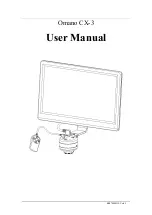
TROUBLESHOOTING GUIDE
FOR PR-33-S AND PR-33-AC
6 (10)
January 9, 2015
K-PATENTS OY
•
Postal Address: P.O.Box 77, FI-01511 Vantaa, Finland
•
Street Address: Elannontie 5, FI-01510 Vantaa, Finland
•
Tel. int.+358 207 291 570
Fax int.+358 207 291 577
•
•
www.kpatents.com
•
VAT No. FI03035575
•
Business ID 0303557-5
•
Registered in Helsinki
The QF-value is related to the quality of the optical image and the slope (higher QF is better). However, the
sharpness of the slope and the QF-value can vary significantly depending on the application. The best way
to exploit the QF-values is to follow and record the changes in the QF which can reveal the changes on the
prism surface.
If the prism is damaged, there can be several dips on the slope which can disturb the measurement. As long
as the slope of the real measurement point is steep, the measurement is not lost. In the case of prism
coating the slope typically weakens which can lead to losing the measurement. However, low optical image,
high spikes, irregular form of the optical image or very weak slopes indicate that actions are required.
Typically, visual check of the prism condition and cleaning with a glassfiber brush is enough to resolve
measurement related problems. Replacement of the prism needs to be considered if there are any marks on
the prism surface.
Diagnostic Values
The instrument has several diagnostic values that can be used to inspect the condition of the instrument and
for troubleshooting purposes. Especially, the LED and the QF-value can be informative when interpreting the
optical images.
Explanation
Units / Range
CONC
Concentration
several units
TEMP
Temperature
°C / °F
CCD
Light activation of the CCD
%
nD
Refractive index
-
CALC
Calculated concentration
raw value
QF
Quality factor
typically 0-200
LED
Amount of light from the LED 0-100 %
HD TEMP Inside temperature
alarm at 65 °C
HD HUM
Inside humidity
alarm at 60 %
Table 1
Instrument diagnostic values
Interpretation of the Diagnostics
Measurement status: Indicates the current situation of the measurement. It also provides error messages.
The messages can be the following: Normal operation, No sample, Prism wash, Recovering, No sensor,
High sensor humidity, etc.. The complete list of different messages with descriptions can be found in the




























